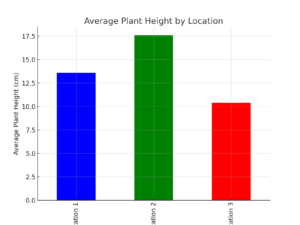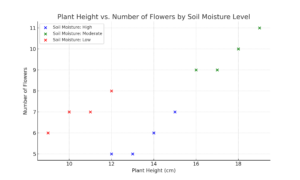Blog Post 8: Tables and Graphs
In this stage of my research, I focused on visualizing the data collected from my study of dandelion (Taraxacum officinale) growth across different environmental conditions in the forested park near Mississauga, ON. The main goal was to illustrate how soil moisture and sunlight exposure impact dandelion abundance, height, and overall growth.
Graph Creation and Data Organization
Data Visualization: Using Excel, I created a series of bar graphs and scatter plots to represent the data. My initial challenge was deciding which data to emphasize. I ultimately decided to focus on how the average dandelion height varied across the three locations with differing soil moisture levels. Each location had five replicates, and I measured plant height, leaf length, and the number of flowers per plant.
Difficulties Encountered: I encountered some difficulties in deciding how to organize the data for visualization. There were many possible ways to display the information, and I was initially uncertain about the best approach. After some trial and error, I found that scatter plots were effective for showing the relationship between soil moisture and plant height, while bar graphs were better for comparing average heights across locations.
Another challenge was dealing with the variability in the data. The dandelions in the drier areas exhibited more variability in height and flower production than I anticipated, which made it difficult to create a clear and concise graph. To address this, I added trend lines to my scatter plots to help visualize the general patterns.
Outcomes and Insights: The data revealed that dandelions in areas with moderate soil moisture had the tallest plants and the highest number of flowers, which supported my hypothesis. However, an unexpected observation was that dandelions in the driest location (Location 3) had a higher number of flowers relative to their size. This suggests that even under suboptimal conditions, dandelions may prioritize reproduction, possibly as an adaptive strategy to ensure their survival.
Further Exploration: This finding has prompted me to consider further exploration into how environmental stress influences reproductive strategies in dandelions. I am particularly interested in examining whether this trend persists across different environmental conditions and whether other factors, such as soil pH or nutrient levels, might also play a role.
In the future, I plan to expand my data collection to include more locations and additional variables to gain a deeper understanding of the complex interactions affecting dandelion growth and reproduction.

This is excel form below: